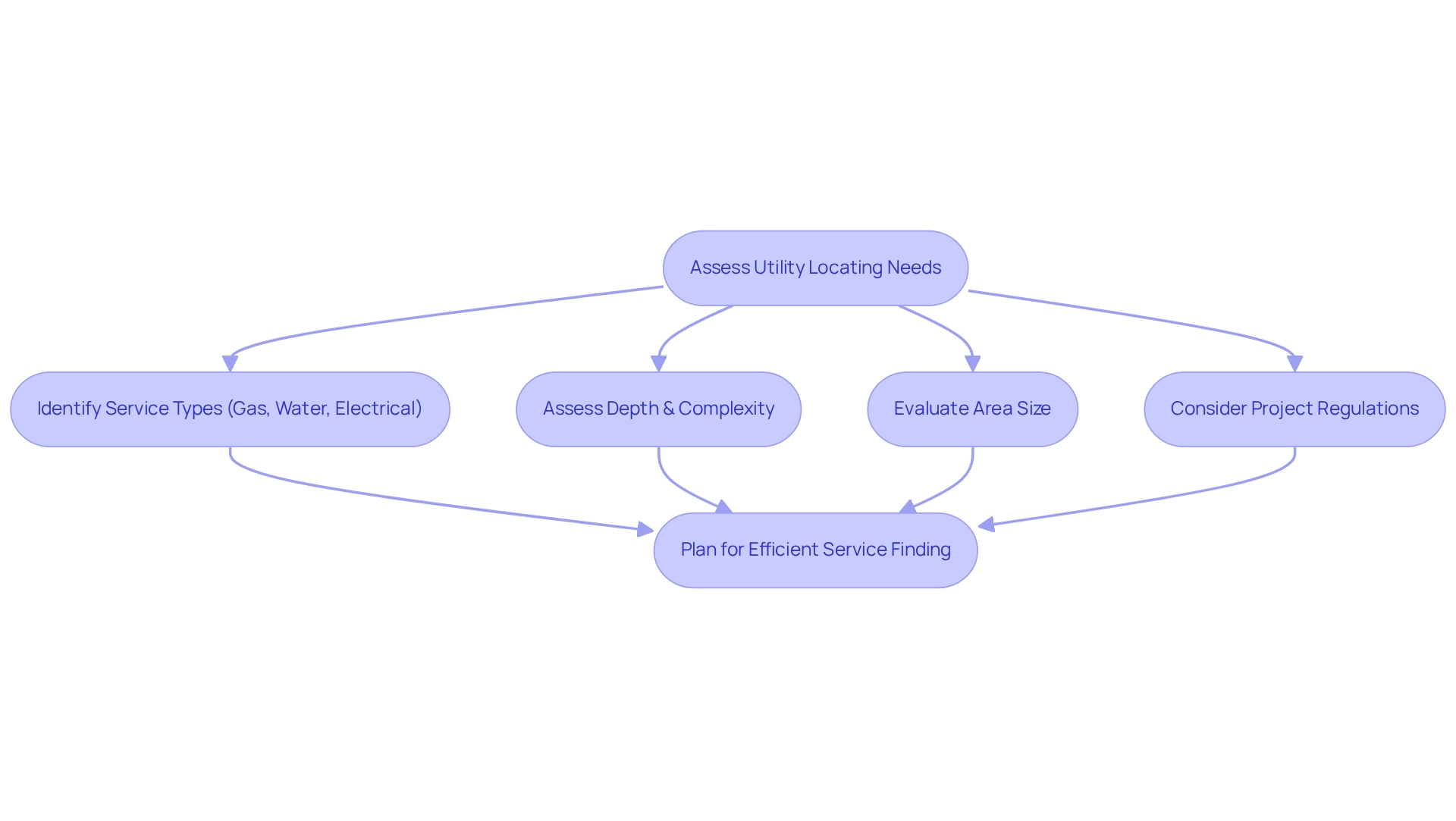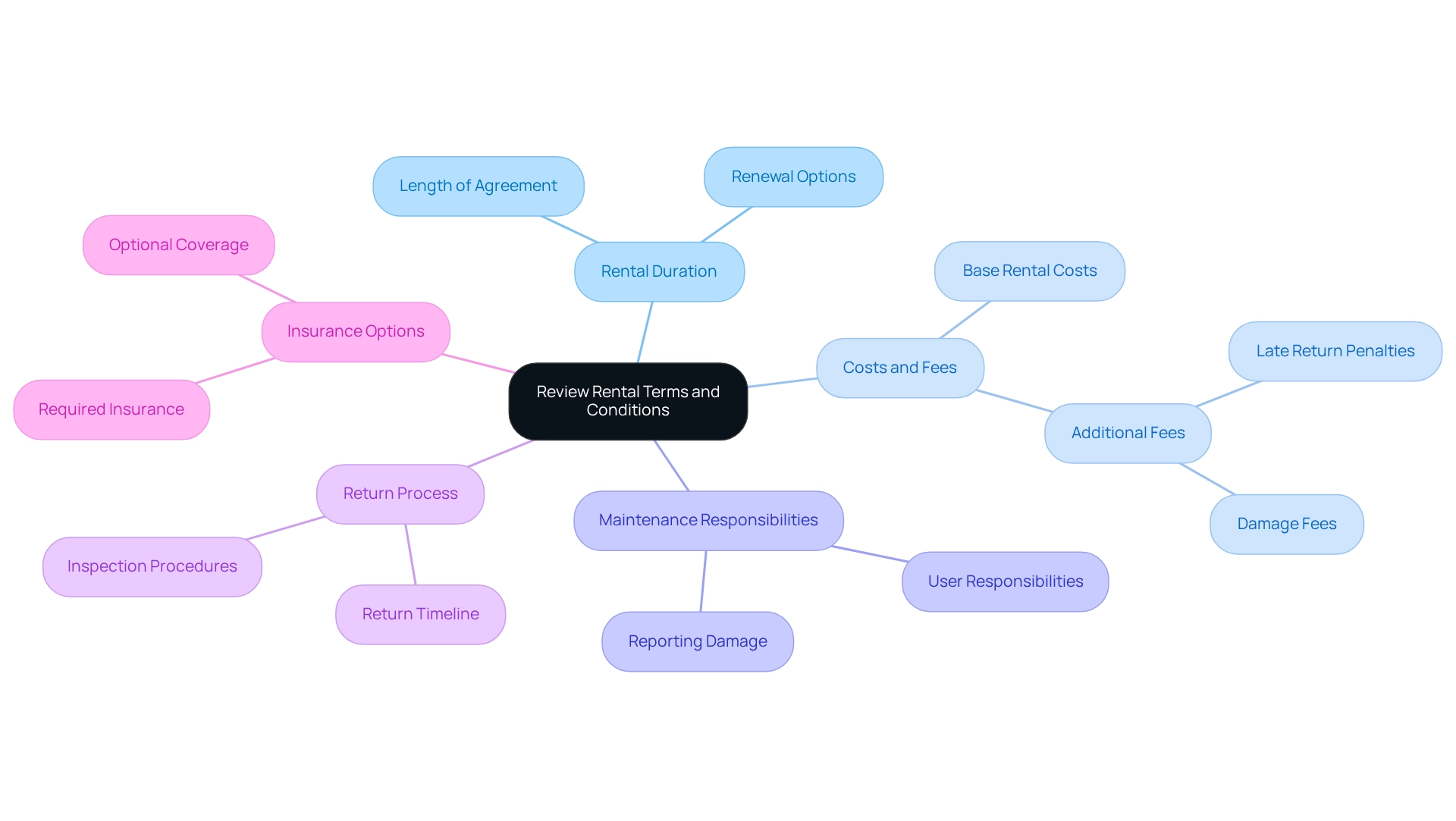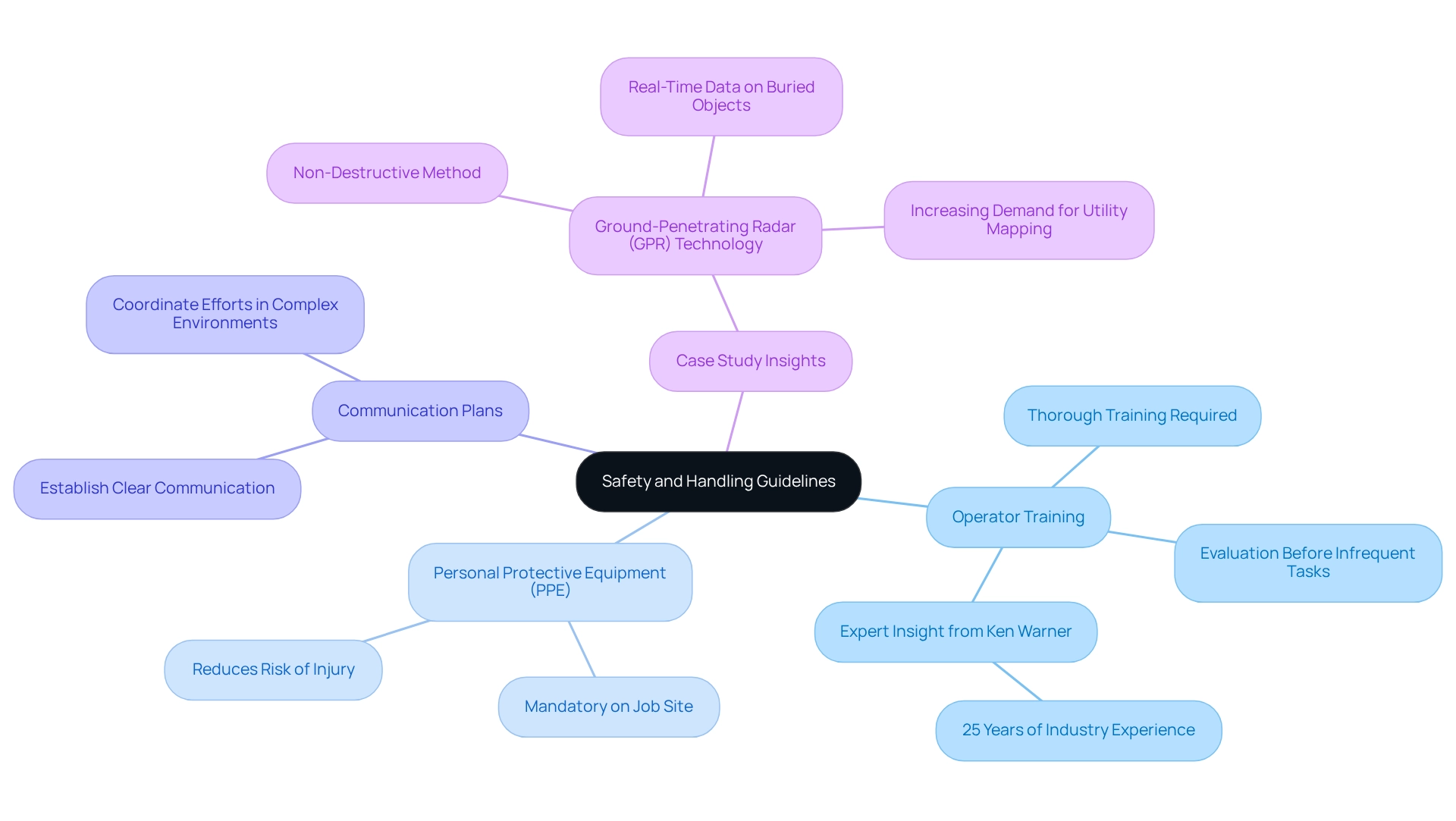Overview
When it comes to renting utility locators for construction projects, it is essential to first identify the specific utility services required. This foundational step allows you to research local rental options online effectively. Be sure to consider customer reviews, as they provide valuable insights into the reliability of the services available.
Understanding rental terms is crucial; they can significantly impact your project's success. Compliance with safety guidelines is non-negotiable, as it not only protects your team but also enhances overall project efficiency. Moreover, inspecting the equipment before use is a vital practice that minimizes risks and ensures that you are equipped with reliable tools.
By prioritizing these aspects, you position your project for success. Engage with local rental services today to explore your options and secure the right utility locators for your needs. Don't hesitate—take action now to enhance your project's efficiency and safety.
Key Highlights:
- Identify specific utility services (gas, water, electrical) required for construction projects to evaluate locating needs.
- Utility depths can vary significantly, influencing the tools and methods for locating services.
- Larger project areas may require advanced equipment like ground-penetrating radar and electromagnetic detection.
- Compliance with local codes and safety standards is essential to avoid delays and hazards.
- Utilize online platforms to find local utility locator rental options and assess customer reviews for reliability.
- Directly contact rental companies for availability and pricing, ensuring good customer service.
- Inspect rental equipment in person to ensure it meets project requirements.
- Read rental agreements thoroughly, paying attention to duration, costs, maintenance responsibilities, and return processes.
- Inquire about insurance options to safeguard against unforeseen circumstances during the rental period.
- Follow safety guidelines, including proper training and using personal protective equipment (PPE) when operating rented equipment.
Introduction
Navigating the complexities of utility locating in construction projects is not just important; it is a critical factor that can significantly influence project success. With a myriad of utilities buried beneath the surface—including gas and water lines as well as electrical cables—grasping how to effectively assess and manage these elements is essential.
This article will guide you through the necessary steps for:
- Evaluating utility locating needs
- Researching local rental options for equipment
- Adhering to safety guidelines
By ensuring that construction teams are well-equipped to tackle the challenges of subsurface work, we can enhance overall efficiency and minimize risks. Embracing meticulous planning and informed decision-making is key to streamlining projects and achieving desired outcomes.
Assess Your Utility Locating Needs
To effectively evaluate your service identification requirements in construction projects, begin by determining the specific types of services that must be identified, including gas, water, and electrical lines. Understanding the range of services available is crucial, as each category may present varying locating needs and complexities.
Next, assess the depth and complexity of the resources within your project area. Recent statistics from the North American Electric Reliability Corporation (NERC) reveal that utility depths can vary significantly, with some buried as deep as 10 feet, depending on local regulations and soil conditions. This variability influences the selection of tools and methods employed for locating these services.
Furthermore, consider the size of the area that requires surveying. Larger areas may necessitate advanced equipment and a strategic approach to ensure comprehensive coverage. For example, projects spanning several city blocks may require a combination of ground-penetrating radar and electromagnetic detection tools to accurately map services.
Additionally, account for any specific project needs or regulations that may affect service identification. Compliance with local codes and safety standards is paramount, as failure to adhere to these can result in costly delays and safety hazards. As Tamar Shafrir, a researcher focused on subsurface challenges, emphasizes, understanding the complexities of the subsurface is vital for successful project execution. By thoroughly evaluating these factors, you can ensure that your service finding efforts are efficient and effective, ultimately contributing to the success of your construction project. Moreover, recent case studies highlight the challenges encountered in infrastructure construction, such as supply chain disruptions and labor shortages, underscoring the significance of meticulous planning in location identification.

Research Local Rental Options
To effectively investigate utility locator rental near me options, begin by utilizing online platforms to identify companies in your vicinity. This crucial first step allows you to compile a list of potential providers. Next, delve into customer feedback and ratings for these leasing companies. High-quality online evaluations play a vital role in establishing user confidence and choices, as they significantly mitigate perceived risks associated with leasing.
Once you have gathered insights from reviews, reach out to local equipment leasing companies, such as EZ Equipment Leasing, to inquire about availability and pricing for specific machinery like boom lifts, excavators, and forklifts. This direct communication not only clarifies costs but also provides an opportunity to evaluate the responsiveness and customer service of the leasing company. EZ Equipment Rental is committed to exceptional customer service, ensuring that you receive the support you need throughout the leasing process. As Josh Nickell, vice president of gear leasing at the American Rental Association, notes, "Uncertainty is not detrimental for leasing... when a contractor is facing uncertainty and elevated interest rates, they tend to lease, and that boosts leasing penetration."
Additionally, consider visiting leasing locations in person. Inspecting the equipment before renting guarantees that it meets your project requirements and quality standards. This practical approach also helps you build a rapport with the leasing staff, who can offer valuable guidance and suggestions tailored to your specific needs. The significance of online reviews in the sharing economy further underscores that high-quality reviews are essential for minimizing perceived risks and enhancing perceived value.
By following these steps, you can make informed decisions when selecting a utility locator rental near me, which will ultimately improve the efficiency and success of your construction projects. The flexibility of renting allows you to easily adjust your resource requirements, adapting to the demands of your projects without the constraints of ownership.
Review Rental Terms and Conditions
When entering into a rental agreement, it is crucial to read the document thoroughly. Pay close attention to the duration of the rental, the associated costs, and any additional fees that may apply. Understanding these elements ensures that you are fully aware of your financial commitments and prevents any unexpected charges.
Equally important is grasping the terms regarding maintenance and damage liability. Knowing your responsibilities in these areas not only protects you but also helps maintain the integrity of the rented equipment. This understanding fosters a sense of accountability and encourages proper usage, which ultimately benefits both parties involved.
Additionally, clarify the process for returning the items. Familiarize yourself with any penalties for late returns, as this knowledge can save you from incurring unnecessary fees. A clear understanding of these terms allows for a smoother rental experience, reducing stress and ensuring compliance with the agreement.
Finally, inquire about insurance options or requirements for the rental period. This step is vital in safeguarding your interests and ensuring that you are prepared for any unforeseen circumstances. By taking these proactive measures, you can engage confidently with the rental process, knowing you have covered all essential aspects.

Follow Safety and Handling Guidelines
Adhering to the manufacturer's safety instructions for the utility locator rental near me is paramount to ensure proper usage and minimize risks. All operators must be thoroughly trained and well-acquainted with the machine's operation; this is crucial for safe and effective use. As industry expert Ken Warner, with nearly 25 years of experience, highlights, proper training is essential for operator readiness, particularly for tasks performed infrequently.
Utilizing personal protective gear (PPE) as mandated on the job site is essential, as it significantly reduces the risk of injury during operation. Safety experts emphasize that appropriate PPE is critical for safeguarding operators from potential dangers associated with locating tasks. Furthermore, establishing a clear communication plan among team members during equipment operation is vital. Effective communication coordinates efforts and ensures safety, especially in complex construction environments where multiple tasks may occur simultaneously.
Insights from the case study on Ground-Penetrating Radar (GPR) technology underscore the importance of service mapping and inspection. This non-destructive method provides real-time data on the location and composition of buried objects, reinforcing the necessity of adhering to safety guidelines during operations that involve utility locator rental near me.

Conclusion
Successfully navigating the complexities of utility locating in construction projects is paramount for ensuring efficient and safe operations. By carefully assessing utility locating needs—including understanding the types of utilities present and their specific requirements—construction teams can better prepare for the challenges that lie beneath the surface. The importance of thorough planning cannot be overstated, as it directly impacts project execution and compliance with local regulations.
Researching local rental options for equipment is another critical step in this process. By leveraging online platforms and customer reviews, teams can make informed decisions that enhance the overall effectiveness of their projects. Establishing strong relationships with rental companies and ensuring equipment quality through firsthand inspections further contributes to a successful utility locating experience.
Furthermore, adhering to safety and handling guidelines is essential. Proper training for operators, the use of personal protective equipment, and effective communication among team members are crucial for minimizing risks and enhancing safety on site. Emphasizing these practices not only protects the workforce but also ensures that projects remain on track and within budget.
In conclusion, meticulous planning, informed decision-making, and a strong focus on safety practices form the foundation for successful utility locating in construction. By prioritizing these elements, construction teams can navigate subsurface challenges effectively, leading to improved project outcomes and reduced risks. Embracing these strategies will ultimately pave the way for a more efficient and safer construction environment, benefiting all stakeholders involved.
Frequently Asked Questions
What types of services should be identified in construction projects?
In construction projects, it is essential to identify specific types of services such as gas, water, and electrical lines.
Why is it important to understand the range of services available?
Understanding the range of services available is crucial because each category may have different locating needs and complexities.
How does the depth of utilities affect service identification?
The depth and complexity of resources can vary significantly, with utilities buried as deep as 10 feet depending on local regulations and soil conditions, influencing the selection of tools and methods for locating these services.
What considerations should be made regarding the size of the area being surveyed?
Larger areas may require advanced equipment and a strategic approach, such as using a combination of ground-penetrating radar and electromagnetic detection tools to ensure comprehensive coverage.
What specific project needs or regulations should be accounted for in service identification?
It is important to consider compliance with local codes and safety standards, as failure to adhere to these can lead to costly delays and safety hazards.
How does understanding subsurface complexities contribute to project success?
Understanding the complexities of the subsurface is vital for successful project execution, as it allows for more effective service identification and planning.
What challenges are highlighted in recent case studies regarding infrastructure construction?
Recent case studies emphasize challenges such as supply chain disruptions and labor shortages, highlighting the importance of meticulous planning in location identification.




